This is our step-by-step guide on how to dehydrate enchilada sauce. Dehydrating enchilada sauce is real easy to do. It also quickly hydrates if you follow our Dehydrator Chef methods.
We’re going to dehydrate the easy-to-find canned enchilada sauce from our local grocer’s international food aisle. We are looking for brands without any added oils; we’ll use the Pace brand for that reason. There might be other brands, but this is what we can source. Optionally, we can make our own enchilada sauce and then dehydrate it.
Oils and fats do not dehydrate and will eventually turn rancid, even when properly stored under ideal conditions. We want a long shelf life, so read the labels.
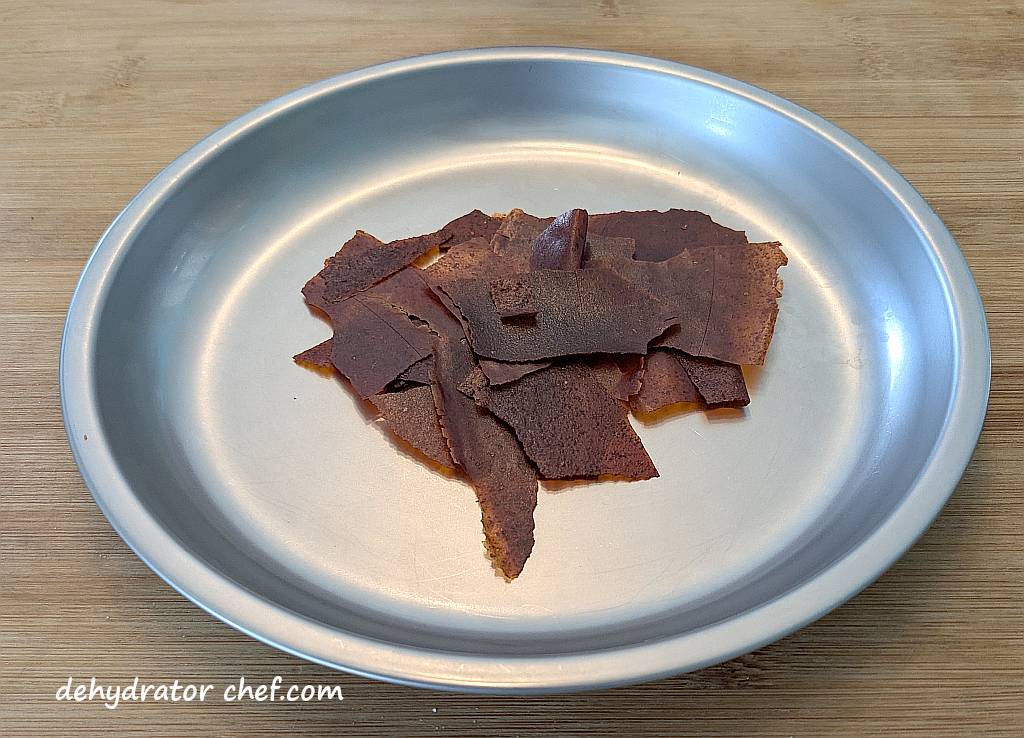
Feel free to swap this dehydrated enchilada sauce for any of your other camping recipes. It’s some seriously good stuff to take your meals up a notch or two.
So, let’s get started dehydrating enchilada sauce.
Table of Contents
- How to Dehydrate Enchilada Sauce
- Supplies Needed to Dehydrate Enchilada Sauce
- Step 1. Process the Enchilada Sauce for Dehydrating
- Step 2. Preparing to Dehydrate Enchilada Sauce
- Step 3. Dehydrating Enchilada Sauce
- Step 4. When is the Dehydrated Enchilada Sauce Done
- Step 5. Equalizing and Conditioning Dehydrated Enchilada Sauce
- Step 6. Storing Dehydrated Enchilada Sauce
- Reconstituting Dehydrated Enchilada Sauce
- Weights, Measures, and Serving Sizes
- Dehydrated Enchilada Sauce Nutrition Information
- Insider Tips
How to Dehydrate Enchilada Sauce
All you need to dehydrate enchilada sauce is a good quality food dehydrator. We use the Nesco food dehydrators. You can check out our food dehydrator guide to learn why we think Nesco offers the best bang for the buck. We believe this is the best food dehydrator for our long-term food storage needs.
Choose a good-quality brand-name enchilada sauce. Read the food label, and look for a brand without oil as an ingredient. We use the Pace brand for that reason. No oil means it will last longer in the dehydrated food pantry.

For planning purposes, one 10.5-ounce can of enchilada sauce will easily fill one of my Nesco 13.5-inch round dehydrator trays with a fruit roll sheet. The Nesco companion fruit roll sheets feature a no-spill lip. With reasonable balance, you can get the fully loaded dehydrator tray from the kitchen workspace to the dehydrator with no loss of product.
The Nesco 13.5-inch round dehydrator tray has close to 119 square inches or .8 square feet of surface area for drying.
Supplies Needed to Dehydrate Enchilada Sauce
- Food dehydrator
- Removable fruit roll sheet inserts, one for each dehydrator tray
- Common kitchen tools, including cutting boards, can openers, spatula, etc.
- Wide-mouth canning jar funnel
- Clear canning jars with tight-fitting lids
- Desiccant packets for moisture control (optional)
Step 1. Process the Enchilada Sauce for Dehydrating
We plan our dehydrator projects and try to fill as many trays as practical with similar foods and drying times. Today, we are drying six 10.5-ounce cans of a quality name-brand enchilada sauce, which will require six trays.
Other than opening the cans, there isn’t much in the way of processing enchilada sauce for dehydration.
Step 2. Preparing to Dehydrate Enchilada Sauce
We know from experience that a 10.5-ounce can of enchilada sauce is the right amount to fill one of our Nesco 13.5-inch round dehydrator trays with a removable fruit roll sheet insert.
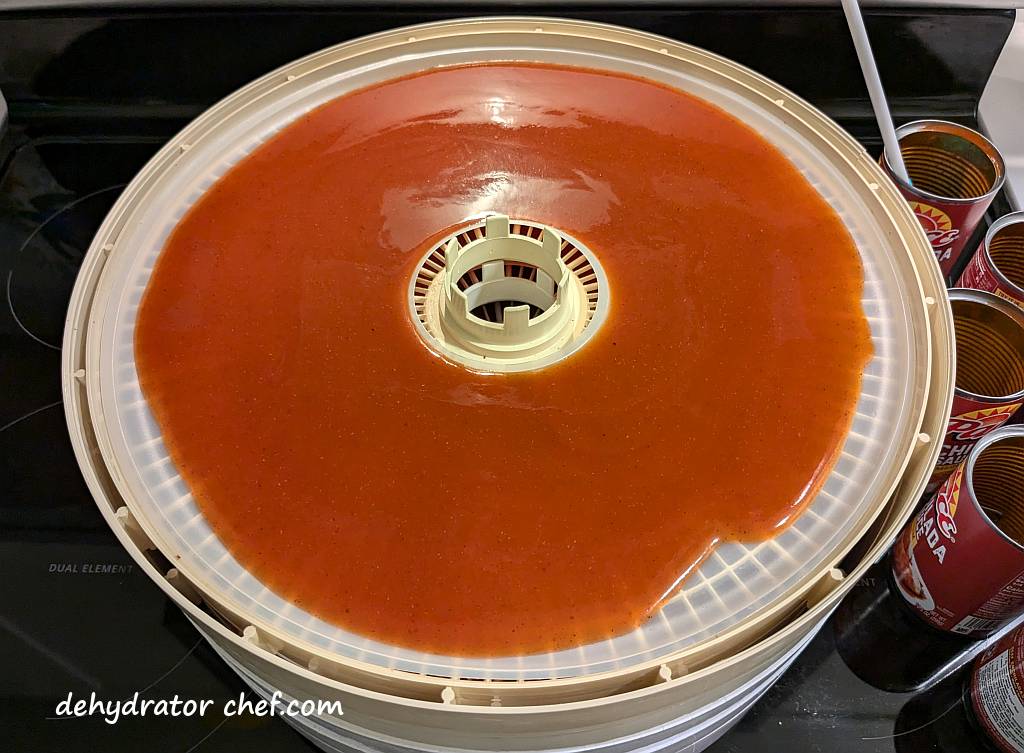
Empty the can’s contents onto the fruit roll sheet. Use a spatula to scoop and scrape out every bit of contents remaining in the can, then smooth it all out for even drying.
The enchilada sauce layer will be somewhere between 1/16 and 3/16 of an inch thick on our 13.5-inch round trays. The 10.5-ounce can is just enough to fill the fruit roll sheet insert without overflowing the edges.
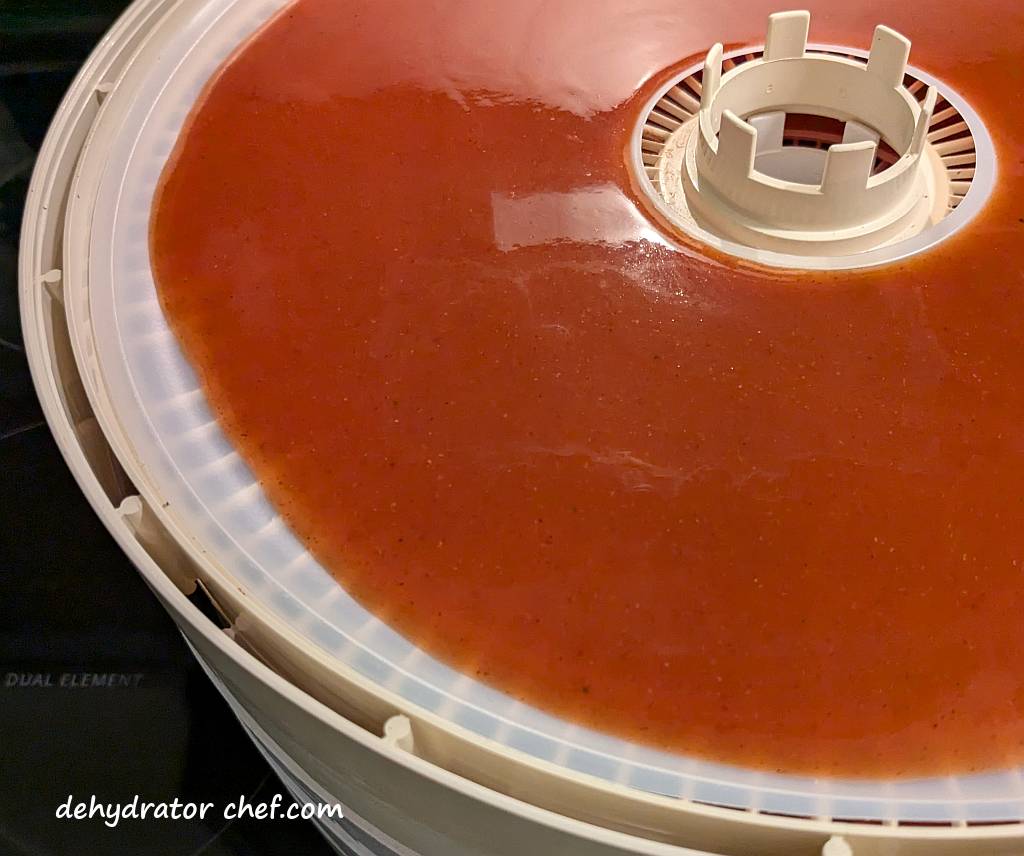
We will use these removable Nesco fruit roll sheet inserts on our food dehydrator for today’s project. They have over 3000 customer reviews with an average rating of 4.5 stars out of 5, which is evidence of a great product. Check out other Nesco food dehydrator products here.
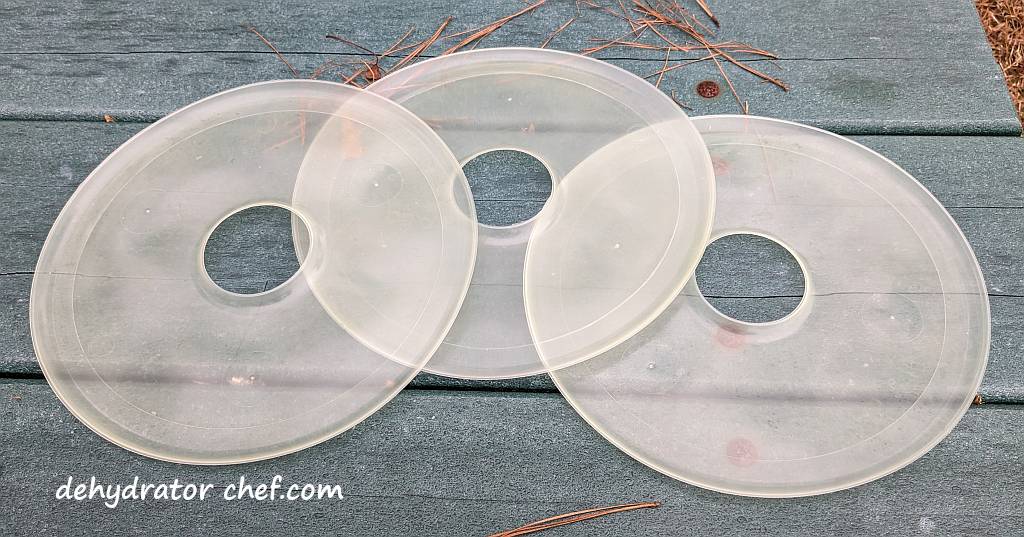
Step 3. Dehydrating Enchilada Sauce
The enchilada sauce has quite a bit of moisture to evaporate, so we’ll dehydrate it at a drying temperature of 160 °F (71 °C). Plan 24 hours or more of drying time. Of course, it’s all dependent on your food dehydrator, the ambient temperature and humidity, and your dehydrator capacity. Remember to use drying times as a guide.

With some dehydrators, rotating the trays helps to speed up the overall drying time. For example, move the top trays to the bottom and the bottom trays to the top. Keep this in mind when dehydrating sauces.
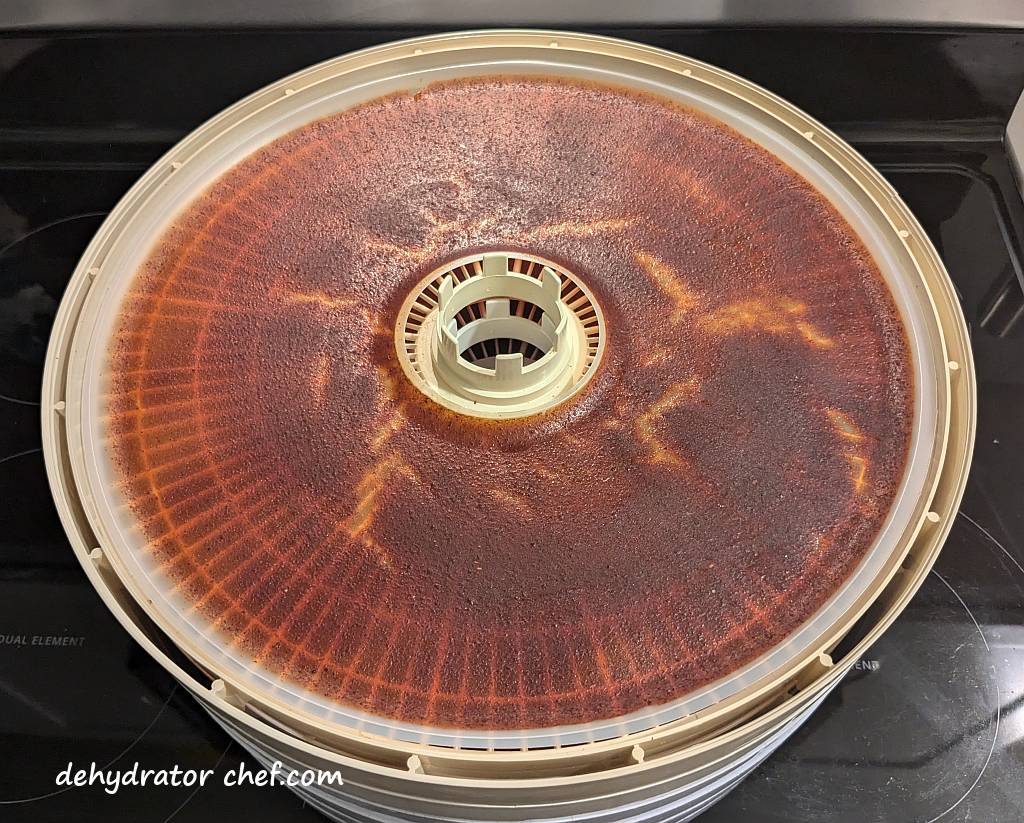
The enchilada sauce will thicken and set and set up in six to eight hours. Peel up the sauce from the fruit roll sheet and flip it over so the bottom is on the top and vice versa. This step will accelerate the overall drying time of the enchilada “leather” and promote more even drying. This step will likely be done in pieces as the “leather” will tend to tear apart.
Step 4. When is the Dehydrated Enchilada Sauce Done
After 24 hours, maybe more, of total dehydrating time, the enchilada sauce should be fully dehydrated. If not, let it go for several more hours and check again.
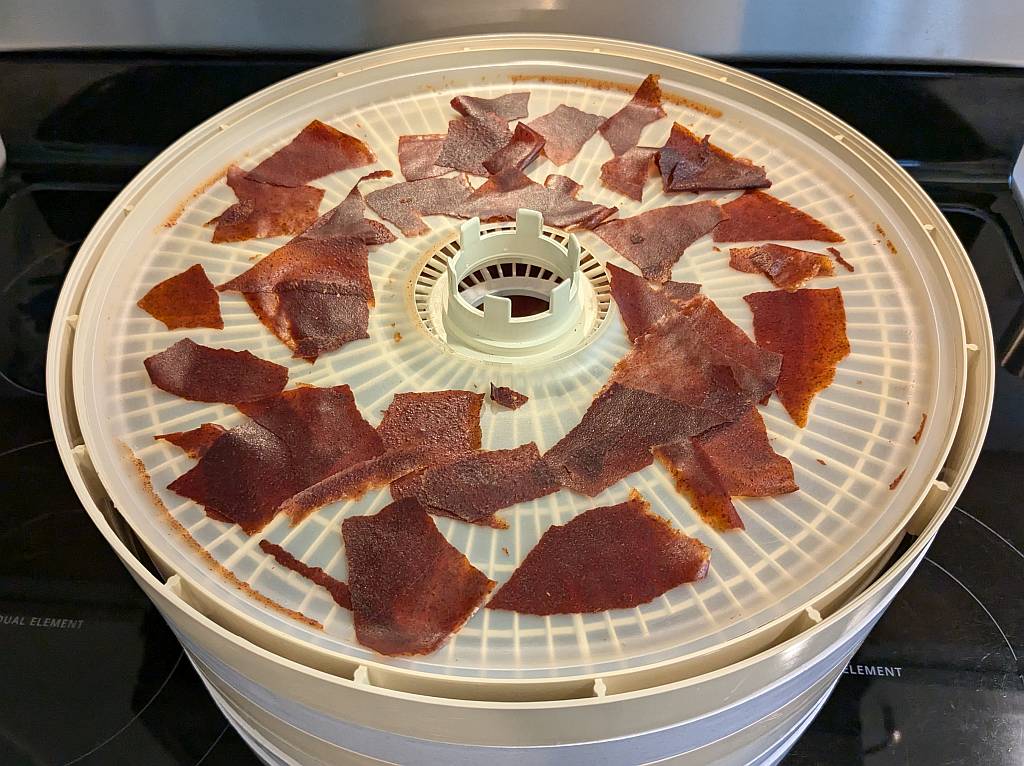
Warm enchilada sauce “leather” still in the food dehydrator will feel somewhat pliable, and you may believe they need more drying time. Just unplug the dehydrator and let everything cool down. Wait 15 or so minutes, and then check again to be sure. As the enchilada sauce cools, it will stiffen considerably.
When done, the dehydrated enchilada sauce should easily crack into pieces when bent, just like potato chips.
Drying times will vary depending on your dehydrator. Refer to your dehydrator owner’s manual for recommended temperatures and times for dehydrating specific foods. Remember to use drying times as a guide.
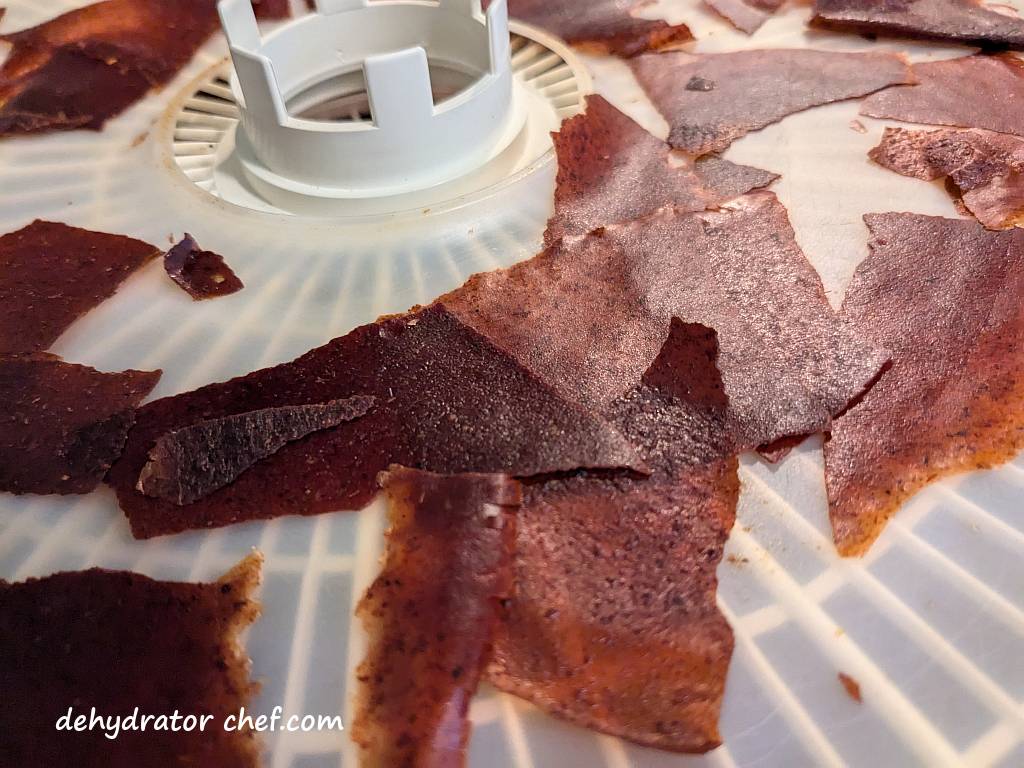
Once finished, break the dehydrated enchilada sauce into smaller dime or nickel-sized pieces for ease of storage and retrieval from the canning jar.
Step 5. Equalizing and Conditioning Dehydrated Enchilada Sauce
When the dehydrated enchilada sauce is removed from the dehydrator and broken into smaller pieces, the remaining moisture may not be distributed equally. Equalizing and conditioning is a process for freshly dehydrated foods that ensures any residual moisture remaining in any piece is spread or equalized among all the other pieces in the batch. Let the dried pieces equalize and condition in the storage container for 7 to 10 days.
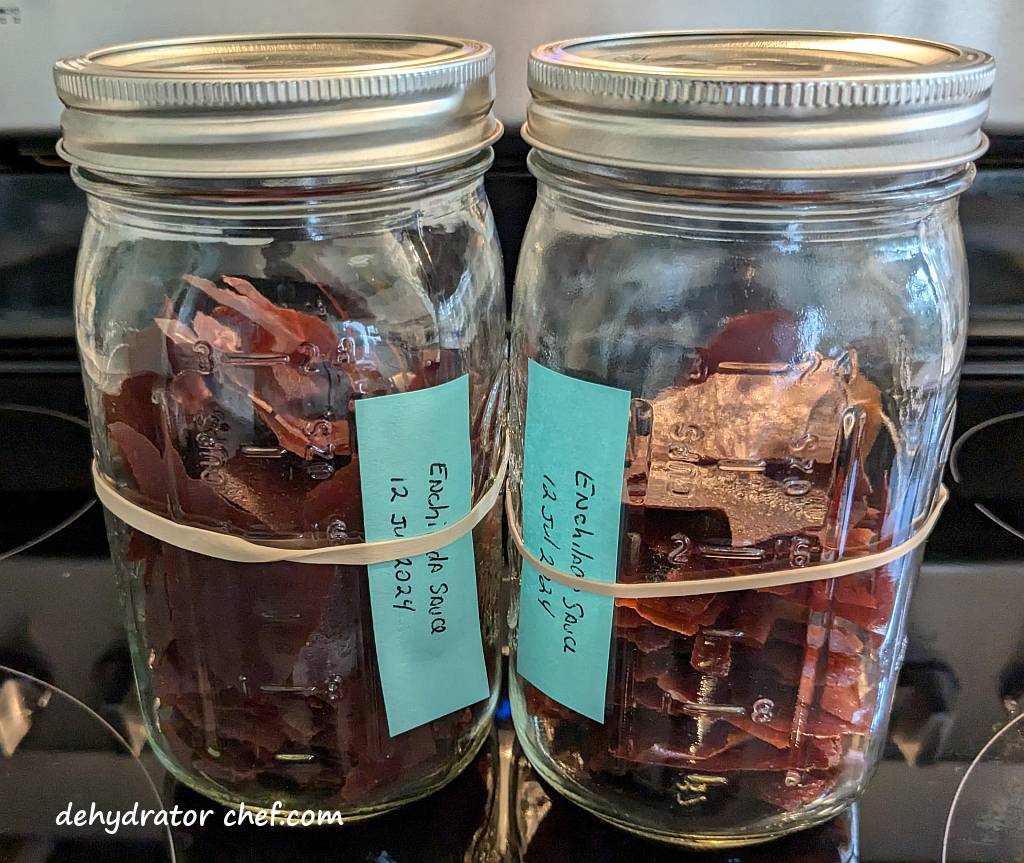
We always recommend letting food items cool completely after they have finished dehydrating and before packing them into an airtight storage container for equalizing and conditioning. Warm food may cause sweating, which could provide enough moisture for mold to grow.
It does not take long for dehydrated food items to start hydrating from ambient household humidity. Do not leave dehydrated food items exposed to the elements any longer than necessary because of the increased risk of mold growth.
After a short cooling period, loosely pack the dehydrated product into a clean, dry, insect-proof, and air-tight storage container. We use quart-size canning jars for conditioning. Since the canning jars are clear, it’s easy to see what’s inside.
A wide-mouth canning jar funnel is handy for the task of getting dehydrated food from the trays into the canning jars with minimal spillage. It’s not a necessity, but having one does make the job easier and faster. If you need one, check them out on Amazon.
For this project, we had 2 of the quart-size canning jars that were just cleaned and dried. Leave some room, known as headspace, in your jars so you can shake and roll the contents around.
Headspace is the distance between the food surface and the lid’s underside. Its purpose is to provide ample space for the dehydrated food product to slide and tumble when shaken and rotated to expose any evidence of clumping or sticking.
Every day, check the jar for moisture. Roll the jar contents around and note any clumping or sticking. If seen, put the contents back on the dehydrator for several more hours. Since canning jars are clear, it’s easy to see what’s inside.
If you notice any mold at all, even the smallest bit, throw it all out. What you see are the mold spores finally blooming enough to make them visible. But there are more, even tinier mold spores in the rest of your jar that make your dehydrated food inedible. Toss it out and start another batch.
Step 6. Storing Dehydrated Enchilada Sauce
Use an appropriately sized canning jar for storage. The dehydrated enchilada should keep for at least 12 months. Exactly how long depends on how well you dehydrate the product and your pantry storage conditions. It is likely that your dehydrated enchilada sauce won’t last that long. It’s good stuff, and you will add it to everything.
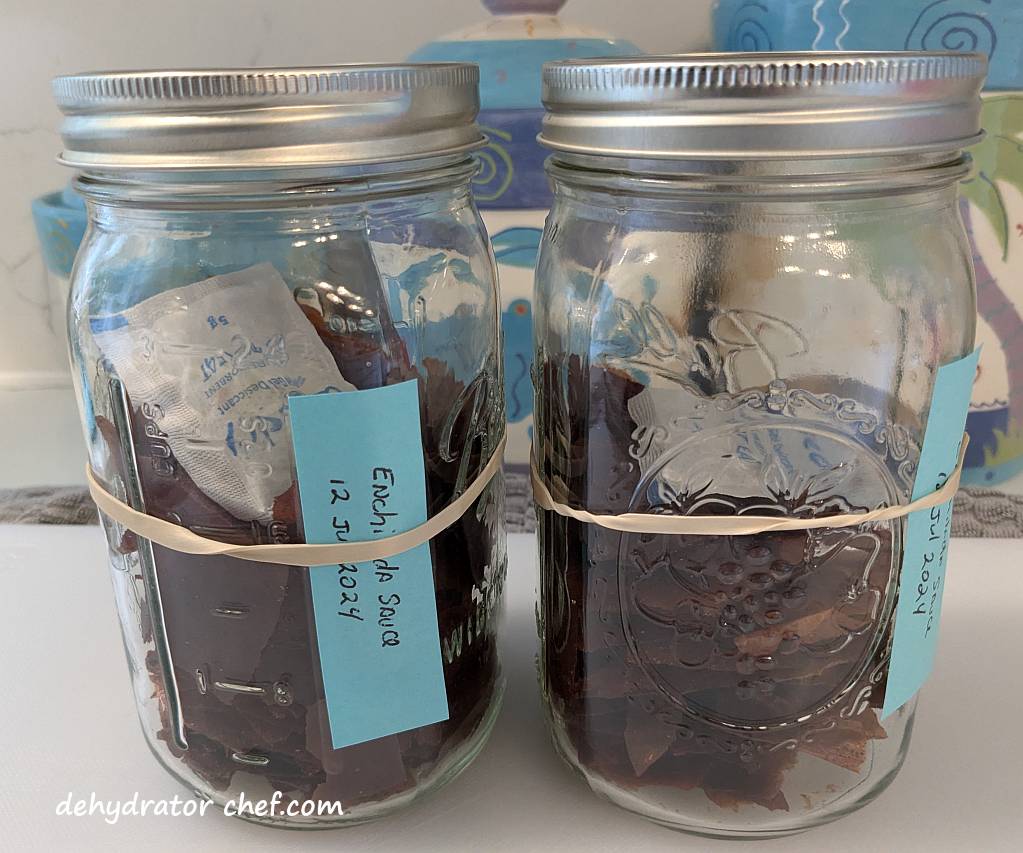
We’ll also use a food-safe desiccant packet for moisture control because we live in a fairly humid area. For our pint-size or quart-size mason jars, we’ll use a single food-safe 5-gram desiccant packet.

We use these inexpensive food-safe desiccant packets, which are available from Amazon. These 5-gram packets have over 5000 of mostly 4- and 5-star customer reviews, with an average of 4.7 stars out of 5. Our bag of 60 desiccant packets will last quite a while because they can be recharged and reused multiple times. Other food-safe sizes are available.
Lastly, I’ll attach or include a short note describing the jar contents and the date the product was dehydrated. The label identifies the canning jar contents, and the date helps with the rotation schedule. A first-in, first-out rotation helps us to use items that have been on the shelf the longest, so we’re using the oldest food first. This method helps us maintain the integrity of dehydrated products. The note also lets me know where to go in my dehydrator logbook if I want to make another note or two.
Reconstituting Dehydrated Enchilada Sauce
When including dried enchilada sauce chips in homemade dehydrated camping food recipes, they should be crushed down into much smaller pieces for better hydration results. Think of peppercorn-sized pieces or smaller.
Optionally, powder the dehydrated enchilada sauce chips using a spice grinder.
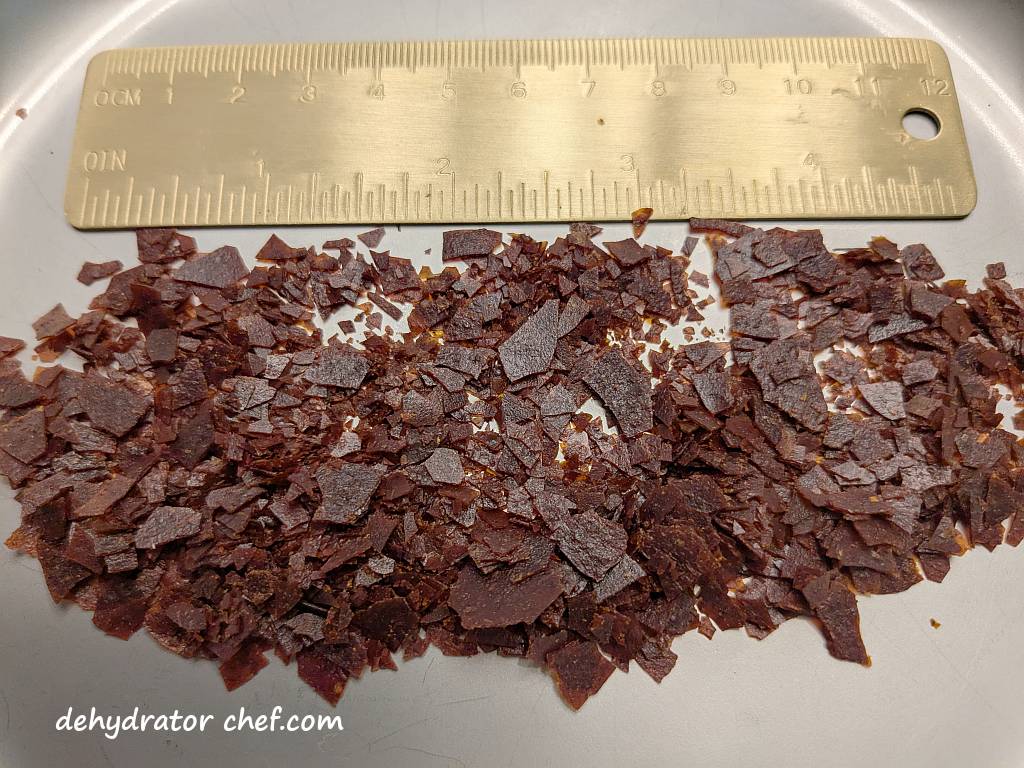
Dehydrated enchilada chips will reconstitute into a chunky salsa-like consistency, not a smooth sauce fresh from the can as we started with.
Dried enchilada sauce hydrates equally well in room temperature or boiled water.
Hydrate the dried enchilada sauce using a 2- or 3-to-1 ratio of dehydrated product to water. Enough to cover the ingredient, plus a tiny bit extra. As a single ingredient, dehydrated enchilada sauce doesn’t take long to rehydrate.
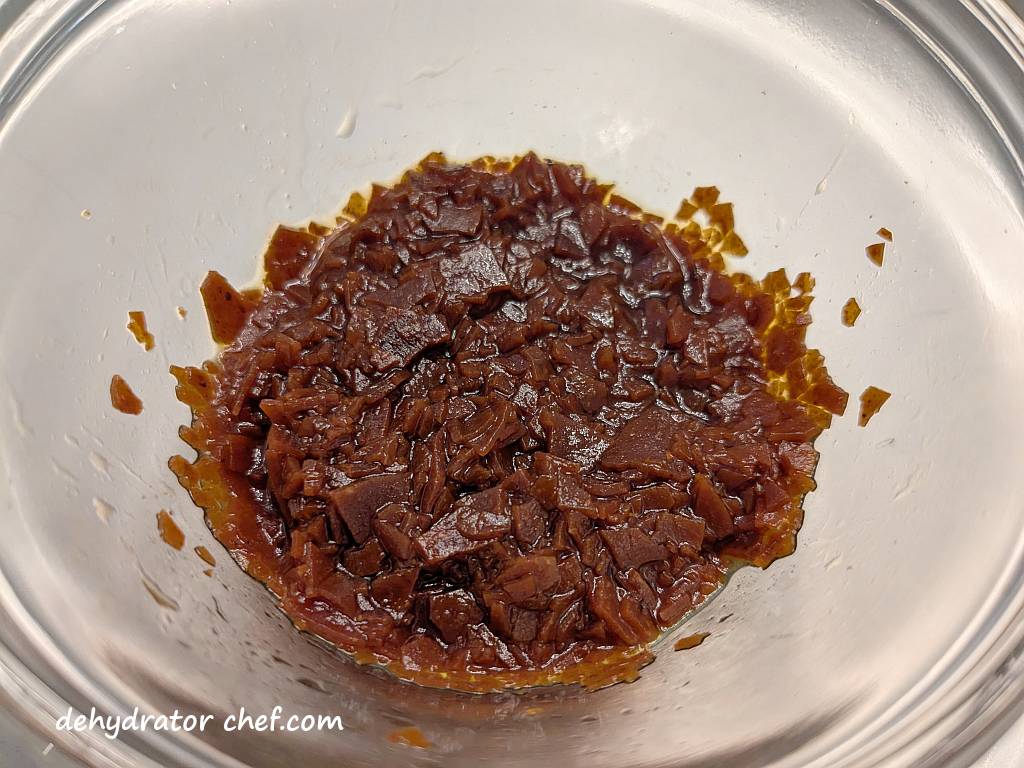
If you’re supplementing store-bought freeze-dried meals as we often do, just add a tad bit more boiling water to the food pouch. Use the same 2- or 3-to-1 ratio of dehydrated enchilada sauce chips to water and account for the extra time.
Weights, Measures, and Serving Sizes
This information is summarized from the notes we keep on most of our food dehydration efforts.
A 10.5-ounce can, about 3.5 servings, of Pace enchilada sauce will dehydrate down to 32 grams, or about 7 grams per serving.
Dehydrated Enchilada Sauce Nutrition Information
Nutrition information is only an estimate and may differ depending on the ingredients you use.
Serving Size: 7 grams | Calories: 60kcal | Total Fat: 0g | Saturated Fat: 0g | Cholesterol: 0mg | Sodium: 270mg | Carbohydrate: 4g | Dietary Fiber: 0g | Sugar: 2g| Protein: 1g
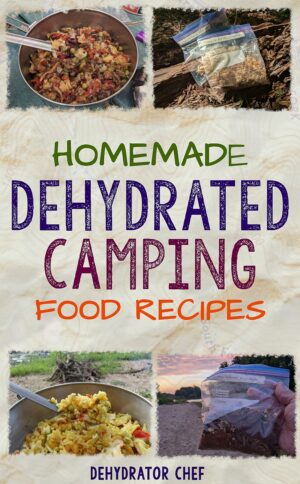 | The Dehydrator Chef Book Available only on Amazon.com You’ll find step-by-step instructions for 26 homemade dehydrated camping meals. Many recipes are only available in this book. Grab yourself a copy today. |
Insider Tips
In addition to the dehydrated meal recipes on this website, you can add dehydrated enchilada sauce to any of your favorite freeze-dried food pouches for a bit more flavor. I don’t know about you, but some of those store-bought freeze-dried meal need to be doctored up flavor-wise.
Just be sure to compensate by adding additional boiled water in roughly a 2 2- or 3-to-1 ratio of dehydrated product to boiling water to the freeze-dried meal and allow enough time for adequate hydration.
Practice these Dehydrator Chef homemade dehydrated camping meal recipes at home several times with the very same outdoor kitchen gear used in the field or at the campsite. This approach lets you practice your skills so you know what to expect and where to adapt.
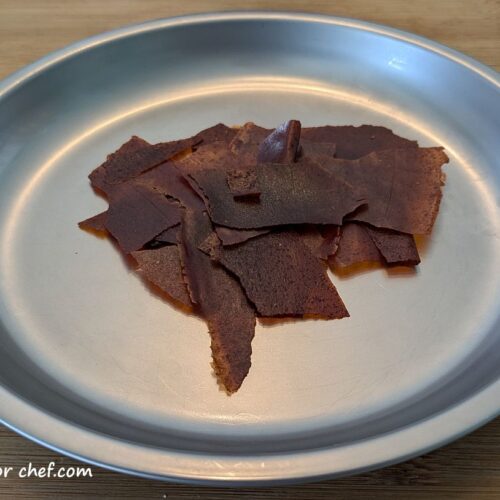
How to Dehydrate Enchalida Sauce
Equipment
- Removable fruit roll sheet insert (one for each dehydrator tray)
- Common kitchen tools (including cutting boards, chef's knife, can opener, spatula, etc.)
- Canning jars with tight-fitting lids
- Desiccant packets for moisture control (optional)
Ingredients
- several cans enchilada sauce (oil-free is preferred)
Instructions
Process the Enchilada Sauce
- Empty the can of enchilada sauce onto the fruit roll sheet. Spread it thin using a spatula.several cans enchilada sauce

Prepare the Dehydrator
- One 10.5-ounce can will fill one 13.5-inch round dehydrator tray.
Dehydrate the Enchilada Sauce
- Set the dehydrator thermostat temperature to 160 °F (71 °C). Dry for 20 to 24 hours until done.
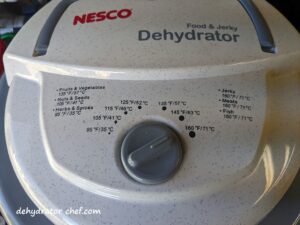
When is the Dehydrated Enchilada Done
- When done, the dried enchilada sauce should easily break into smaller pieces like a potato chip when bent. There should be no wet areas or mushy pieces.

Equalizing and Conditioning Dehydrated Enchilada Sauce
- After a short cooling period, loosely pack the dehydrated enchilada sauce pieces into a clean, dry canning jar with a tight-fitting lid, leaving some headspace.

- Every day, for 7 to 10 days, check the jar for moisture. Roll the jar contents around and note any clumping or sticking. If seen, put it all back on the dehydrator for several more hours.
- If you notice any mold at all, even the slightest bit, throw it all out.
Storing the Dehydrated Enchilada Sauce
- Use appropriate-sized canning jars for storage. Depending on how well you dehydrate the enchilada sauce and your pantry storage conditions, it should keep for at least 12 months.

- An optional food-safe desiccant packet will aid with moisture control.

- Attach or include a label describing the jar contents and the date the product was dehydrated. The label identifies the canning jar contents, and the date helps with the rotation schedule. A first-in, first-out rotation helps us to use items that have been on the shelf the longest, so we're using the oldest food first.
Notes
Nutrition
Nutrition information is only an estimate and may differ depending on the ingredients you use.

One reply on “How to Dehydrate Enchilada Sauce – Dehydrating Enchilada Sauce, A Step-by-Step Guide”
nice